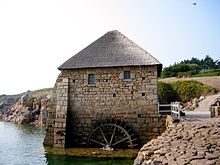
This list of early medieval watermills comprises a selection of European watermills spanning the early Middle Ages, from 500 to 1000 AD.

This list of early medieval watermills comprises a selection of European watermills spanning the early Middle Ages, from 500 to 1000 AD.
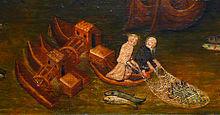
Largely unaffected from the turbulent political events following the demise of the Western Roman Empire, the importance of watermilling continued to grow under the new Germanic lords. The sharp rise in numbers of early medieval watermills coincided with the appearance of new documentary genres (legal codes, monastic charters, hagiography) which were more inclined to address such a relatively mundane device than the ancient urban-centered literary class had been. [1] This partly explains the relative abundance of medieval literary references to watermills compared to former times. [2]
The quantitative growth of medieval evidence appears to be more than a mere reflection of the changing nature of surviving sources. By Carolingian times, references to watermills in the Frankish Realm had become "innumerable". [3] At the time of the compilation of the Domesday Book (1086), there were an estimated 6,500 watermills in England alone. [4]
By the early 7th century, watermills were well established in Ireland, and began to spread from the former territory of the empire into the non-romanized parts of Germany a century later. [5] The introduction of the ship mill and tide mill in the 6th century, both of which yet unattested for the ancient period, [6] allowed for a flexible response to the changing water-level of rivers and the Atlantic Ocean, thus demonstrating the technological innovativeness of early medieval watermillers.
Below the earliest medieval evidence for different types of watermills. This list complements its ancient counterpart.
| Date | Water-powered mill types | Find spot (or reference) | Location |
|---|---|---|---|
| 537 | Ship mill [7] | Procop V (=Goth. I), 19.19–22 | Rome |
| 6th century | Sawmill; crank and connecting rod system without gear train [8] | Gerasa and Ephesus | Jordan and Turkey |
| 6th century | Vertical-wheeled tide mill [9] | Killoteran near Waterford | Ireland |
| c. 630 | Horizontal-wheeled tide mill [10] [11] | Little Island I | Ireland |
| c. 636 | Horizontal-wheeled mill (Norse or Greek mill) [10] [A 1] | Ballykilleen | Ireland |
In the following, literary, epigraphical and documentary sources referring to watermills and other water-driven machines are listed.
| Reference | Location | Date | Type of evidence | Comments on |
|---|---|---|---|---|
| Annals of Ulster [12] | 650 | Annal | ||
| Benedict of Nursia, Regula 66.6–7 [13] | 529/547 | Possible watermill | ||
| Caesarius of Arles, Sermones, VIII, 4 [14] | Early 6th century | |||
| Cassiodorus, Variae III, 31.2 [15] | 510/511 | |||
| Charter of king Childebert I [16] | Paris | 556 | Charter | Ship mill |
| Charter of king Dagobert II [17] | Trier | 646 | Charter | |
| Charter of king Ethelbert of Kent [18] | 762 | Charter | ||
| Charter [19] | Wang-Thulbach | 754 | Charter | Possible watermill |
| Charters [20] | Lorsch Abbey | 760s onwards | Charter | |
| Edictus Rothari 149–151 [21] | 643 | Legal code | ||
| Gregorius Turonensis, Historia Francorum III, 19 [16] | Dijon | c. 575 | Historiography | Ship mill |
| Gregorius Turonensis, Vitae Patrum, XVIII, 2 [3] | 484/507 | Hagiography | ||
| Lex Alamannorum, 79–80 [22] | 717/719 | Legal code | ||
| Lex Baivariorum, IX, 2 [22] | Probably 725/728 | Legal code | ||
| Lex Visigothorum, VII, 2.12 and VIII, 4.30 [21] | 568/586 | Legal code | ||
| Marius Aventicius, Chronica [16] | Geneva | 563 | Annal | Ship mill |
| "Muliheim" [19] | Near Niederalteich | 731 | Charter | Likely watermill site |
| Nomos georgikós 81–82 [21] | Late 7th century | Legal code | ||
| Pactus Alamannorum, V, 14 [22] | Early 7th century | Legal code | ||
| Pactus legis Salicae, Recensio Guntchramna, X, 6; XII, 1–3; XXXI, 3 [15] | 567/596 | Legal code | ||
| Procop V (=Goth. I), 19.19–22 [16] | Rome | 537 | Historiography | Ship mills |
| Senchus Mòr, De ceithri slichtaib Athgabála [21] | c. 600 | Legal code | ||
| Venantius Fortunatus, Carmina, III, 12, 37–8 [17] | c. 600 | |||
| Vita Haimhrammi, 37 [23] | Thuringia | c. 770 | Hagiography | Watermill (?) machinery |
| Vita Leobae, 12 [22] | c. 740 | Hagiography | ||
| Vita S. Orienti, II, 3 [3] | c. 380/420? | Hagiography | ||
| Vita Sturmi, 20 [24] | Fulda | c. 765 | Hagiography | Mill-channel |
| Vita S. Brigidae virginis, cols. 787–8 Migne [12] | c. 650 | Hagiography | ||
| Vita S. Remigi episcopi Remensis, 17 [3] | 486/511 | Hagiography | ||
Below are listed excavated or surveyed watermill sites dated to the early medieval period.
| Site | Country | Date | Identification/Remains |
|---|---|---|---|
| Ebbsfleet [25] | England | Early 8th century | Horizontal-wheeled tide mill |
| Old Windsor I [10] | England | Probably late 7th century | Mill-channel, woodwork of three vertical water-wheels |
| Old Windsor II [10] | England | 9th or 10th century | Mill-channel, horizontal-wheeled mill |
| Raunds, West Cotton [26] | England | Late Saxon | Leat, sluice gate, chute, stake and wattle lined and stone surfaced wheel-pit |
| Tamworth [10] | England | Between 846 and 864 | Entire establishment |
| Dasing [27] | Germany | 696/697 | Vertical-wheeled undershot or breastshot mill, mill-pond, mill-race, fragments of mill-stones |
| Ballykilleen [10] | Ireland | c. 636 | Horizontal-wheeled mill |
| Cloontycarthy [10] | Ireland | c. 833 | Entire establishment |
| Drumard [10] | Ireland | c. 782 | Horizontal-wheeled mill |
| Killoteran near Waterford [9] | Ireland | 6th century | Vertical-wheeled tide mill |
| Little Island I [10] [11] | Ireland | c. 630 | Horizontal-wheeled tide mill |
| Little Island II [10] [11] | Ireland | 7th century | Vertical-wheeled tide mill |
| Morett [10] | Ireland | c. 710 | Vertical-wheeled undershot mill |
| Gerasa [28] | Jordan | 6th century | Sawmill; crank and connecting rod system without gear train |
| Nendrum Monastery mill [29] | Northern Ireland | 619 & 789 | Horizontal-wheeled tide mill |
| Ephesus [30] | Turkey | 6th century | Sawmill; crank and connecting rod system without gear train; multiple mill complex with at least five watermills |
The following list comprises stray finds of early medieval millstones. Note that there is no way to distinguish millstones driven by water-power from those powered by animals turning a capstan. Most, however, are assumed to derive from watermills. [31]
| Site | Country | Date (or find context) | Remains |
|---|---|---|---|
| Stroud [32] | England | Probably Anglo-Saxon | Mill-paddles from horizontal wheel |
| Moycraig [32] | Ireland | 9th century | Horizontal paddle-wheel, hub and shaft, complete with pebble bearing |
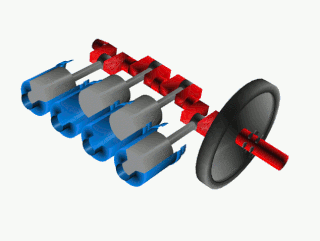
A crankshaft is a mechanical component used in a piston engine to convert the reciprocating motion into rotational motion. The crankshaft is a rotating shaft containing one or more crankpins, that are driven by the pistons via the connecting rods.

Ancient Roman architecture adopted the external language of classical ancient Greek architecture for the purposes of the ancient Romans, but was different from Greek buildings, becoming a new architectural style. The two styles are often considered one body of classical architecture. Roman architecture flourished in the Roman Republic and to an even greater extent under the Empire, when the great majority of surviving buildings were constructed. It used new materials, particularly Roman concrete, and newer technologies such as the arch and the dome to make buildings that were typically strong and well engineered. Large numbers remain in some form across the former empire, sometimes complete and still in use today.

A watermill or water mill is a mill that uses hydropower. It is a structure that uses a water wheel or water turbine to drive a mechanical process such as milling (grinding), rolling, or hammering. Such processes are needed in the production of many material goods, including flour, lumber, paper, textiles, and many metal products. These watermills may comprise gristmills, sawmills, paper mills, textile mills, hammermills, trip hammering mills, rolling mills, wire drawing mills.

A water wheel is a machine for converting the energy of flowing or falling water into useful forms of power, often in a watermill. A water wheel consists of a wheel, with a number of blades or buckets arranged on the outside rim forming the driving car. Water wheels were still in commercial use well into the 20th century but they are no longer in common use today. Uses included milling flour in gristmills, grinding wood into pulp for papermaking, hammering wrought iron, machining, ore crushing and pounding fibre for use in the manufacture of cloth.

A sawmill or lumber mill is a facility where logs are cut into lumber. Modern sawmills use a motorized saw to cut logs lengthwise to make long pieces, and crosswise to length depending on standard or custom sizes. The "portable" sawmill is simple to operate. The log lies flat on a steel bed, and the motorized saw cuts the log horizontally along the length of the bed, by the operator manually pushing the saw. The most basic kind of sawmill consists of a chainsaw and a customized jig, with similar horizontal operation.
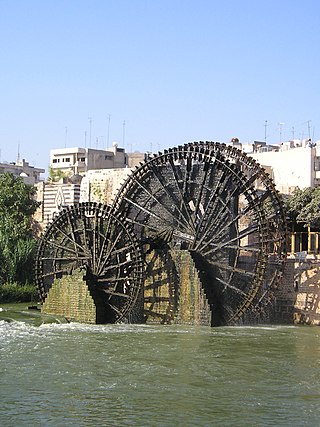
A noria is a hydropowered scoop wheel used to lift water into a small aqueduct, either for the purpose of irrigation or to supply water to cities and villages.

A crank is an arm attached at a right angle to a rotating shaft by which circular motion is imparted to or received from the shaft. When combined with a connecting rod, it can be used to convert circular motion into reciprocating motion, or vice versa. The arm may be a bent portion of the shaft, or a separate arm or disk attached to it. Attached to the end of the crank by a pivot is a rod, usually called a connecting rod (conrod).
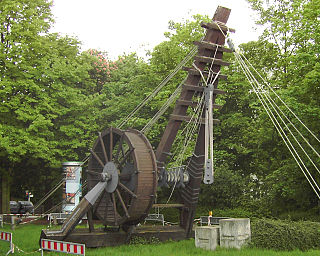
The ancient Romans were famous for their advanced engineering accomplishments. Technology for bringing running water into cities was developed in the east, but transformed by the Romans into a technology inconceivable in Greece. The architecture used in Rome was strongly influenced by Greek and Etruscan sources.

A tide mill is a water mill driven by tidal rise and fall. A dam with a sluice is created across a suitable tidal inlet, or a section of river estuary is made into a reservoir. As the tide comes in, it enters the mill pond through a one-way gate, and this gate closes automatically when the tide begins to fall. When the tide is low enough, the stored water can be released to turn a water wheel.

Renaissance technology was the set of European artifacts and inventions which spread through the Renaissance period, roughly the 14th century through the 16th century. The era is marked by profound technical advancements such as the printing press, linear perspective in drawing, patent law, double shell domes and bastion fortresses. Sketchbooks from artisans of the period give a deep insight into the mechanical technology then known and applied.
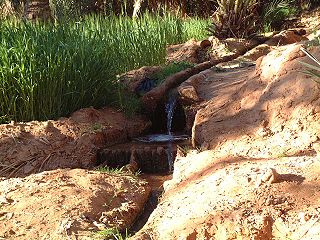
The Arab Agricultural Revolution was the transformation in agriculture in the Old World during the Islamic Golden Age. The agronomic literature of the time, with major books by Ibn Bassal and Abū l-Khayr al-Ishbīlī, demonstrates the extensive diffusion of useful plants to Medieval Spain (al-Andalus), and the growth in Islamic scientific knowledge of agriculture and horticulture. Medieval Arab historians and geographers described al-Andalus as a fertile and prosperous region with abundant water, full of fruit from trees such as the olive and pomegranate. Archaeological evidence demonstrates improvements in animal husbandry and in irrigation such as with the saqiyah waterwheel. These changes made agriculture far more productive, supporting population growth, urbanisation, and increased stratification of society.

Ancient Greek technology developed during the 5th century BC, continuing up to and including the Roman period, and beyond. Inventions that are credited to the ancient Greeks include the gear, screw, rotary mills, bronze casting techniques, water clock, water organ, the torsion catapult, the use of steam to operate some experimental machines and toys, and a chart to find prime numbers. Many of these inventions occurred late in the Greek period, often inspired by the need to improve weapons and tactics in war. However, peaceful uses are shown by their early development of the watermill, a device which pointed to further exploitation on a large scale under the Romans. They developed surveying and mathematics to an advanced state, and many of their technical advances were published by philosophers, like Archimedes and Heron.

Roman technology is the collection of antiques, skills, methods, processes, and engineering practices which supported Roman civilization and made possible the expansion of the economy and military of ancient Rome.

A ship mill, more commonly known as a boat mill, is a type of watermill. The milling and grinding technology and the drive (waterwheel) are built on a floating platform on this type of mill. Its first recorded use dates back to mid-6th century AD Italy.

The Hierapolis sawmill was a Roman water-powered stone sawmill at Hierapolis, Asia Minor. Dating to the second half of the 3rd century AD, the sawmill is considered the earliest known machine to combine a crank with a connecting rod to form a crank slider mechanism.
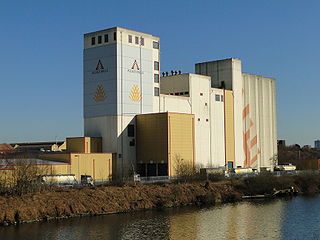
A gristmill grinds cereal grain into flour and middlings. The term can refer to either the grinding mechanism or the building that holds it. Grist is grain that has been separated from its chaff in preparation for grinding.
Örjan Wikander is a Swedish classical archaeologist and ancient historian. His main interests are ancient water technology, ancient roof terracottas, Roman social history, Etruscan archaeology and epigraphy.